Perched on a hillside above the deep-blue Mediterranean, Taormina’s Greek Theater has to be one of Sicily’s most breathtaking ancient wonders. I stumbled across this place during my spring travels last year, and honestly, it’s hard not to get swept up by both the preservation and that jaw-dropping setting.
Built in the third century BC, this Hellenistic masterpiece frames Mount Etna’s looming silhouette and the sparkling coastline. I can’t think of a more perfect backdrop for theater anywhere.
Wandering through the old stone corridors, I kept picturing the performances that have happened here for thousands of years. The Greeks kicked things off with drama and music, then the Romans came along and turned it into a spot for gladiator games.
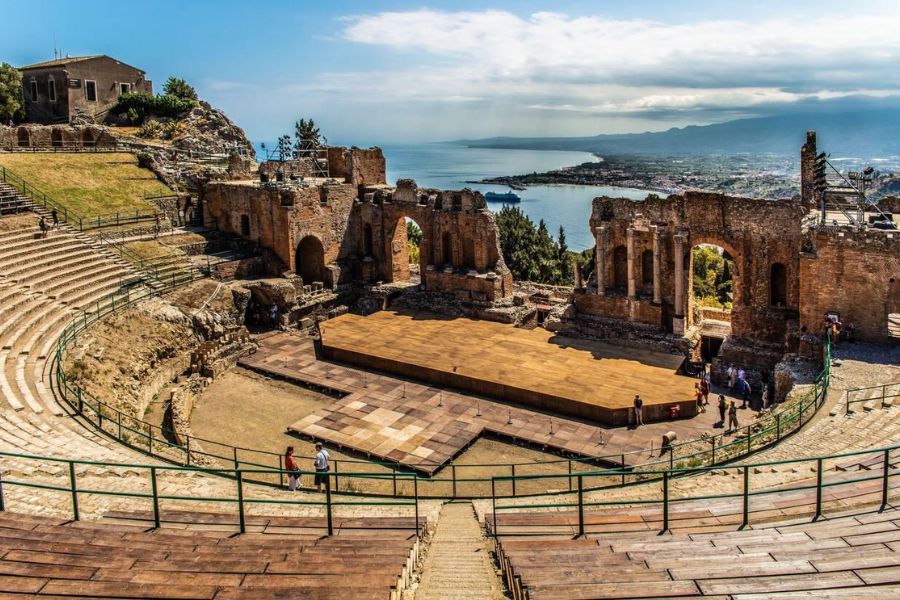
Now, the theater still hosts operas and concerts. You can experience live shows just like audiences did 2,000 years ago—though probably with less togas in the crowd.
My trip to Sicily wouldn’t have felt complete without seeing Taormina’s crown jewel. The structure remains so intact that you can almost touch history, all while soaking up panoramic views from Mount Etna to the glittering sea.
If you’re headed on a Sicilian adventure, try to visit in the cooler morning hours. The golden light then makes the ancient stones practically glow.
History of Taormina Greek Theater
Taormina’s ancient theater really showcases Sicily’s classical heritage. Greeks and Romans both left their mark here, and the Mediterranean views? Always spectacular.
Origins and Ancient Construction
I was honestly amazed to learn the theater dates back to the 3rd century BC, during the Hellenistic period. The Greeks built it when they ruled Sicily, picking this exact spot for its acoustics and stunning panorama.
The original Greek version was smaller than what stands today. It followed classic Greek design, built right into the hillside, using the natural slope to support the “theatron”—seating for about 5,400 people.
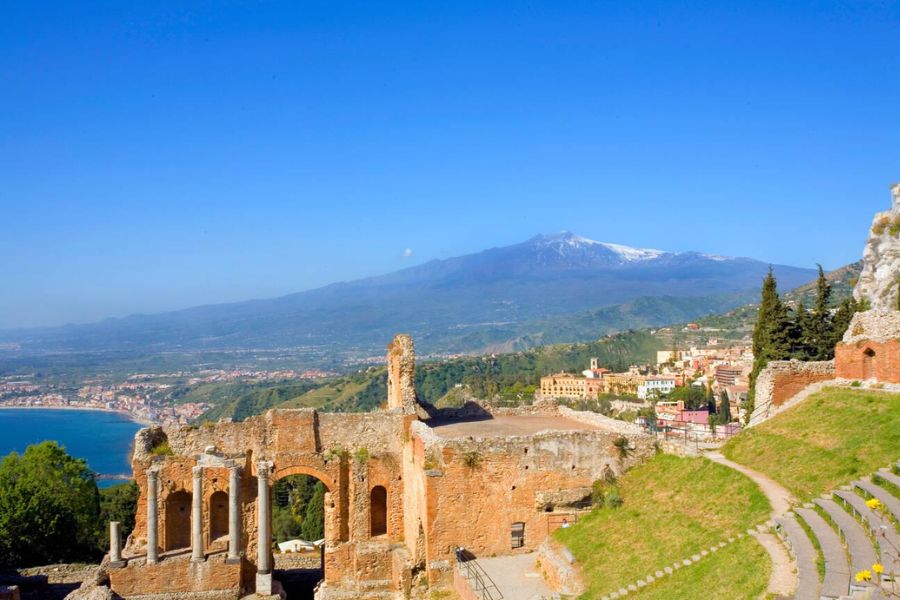
Greek builders worked stone by stone, mainly to host dramatic and musical shows. They used local materials and shaped the venue to fit the terrain, achieving sightlines and acoustics that still impress.
Hellenistic Influences and Roman Expansions
When I visited, I could spot the Roman modifications right away. After conquering Sicily, the Romans expanded the theater in the 2nd century AD.
They widened the orchestra and added elaborate stage buildings called “scaenae frons,” complete with columns and statue niches. The Romans also tweaked the place for their favorite entertainments, like gladiatorial contests, which needed different features.
Brick and marble additions show off Roman engineering, layered on top of the Greek foundation. This blend of styles makes Taormina’s theater stand out among ancient venues in Sicily.
Notable Events Through the Centuries
Over the centuries, this theater has hosted so many performances. In ancient times, Greek tragedies and comedies echoed through the seats. Later, Roman crowds came for drama and gladiator spectacles.
After the Roman Empire fell, the theater slipped into disuse. During medieval times, locals even took stones from it to build elsewhere in Taormina.
By the 18th century, the theater became a must-see stop on the Grand Tour, attracting European aristocrats hunting for classical inspiration.
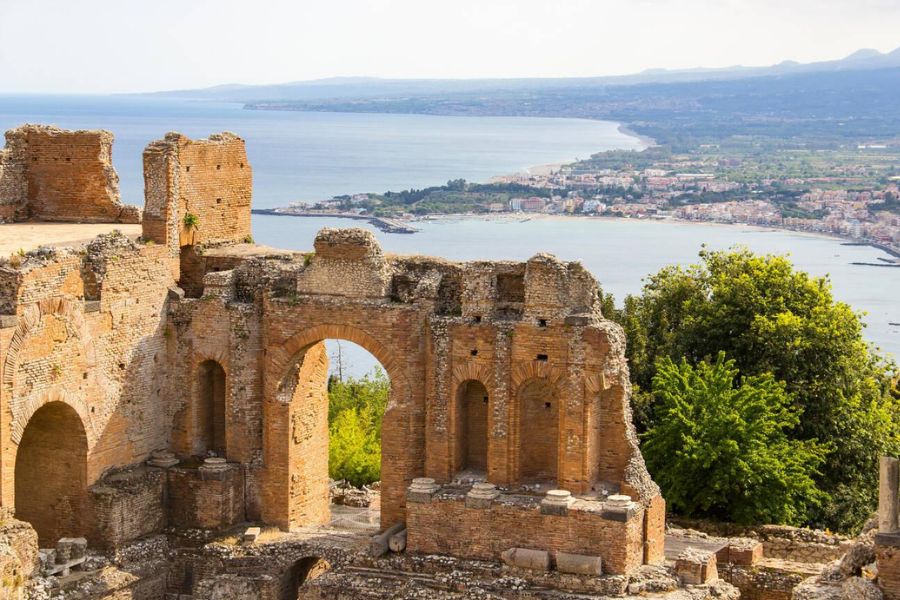
Today, I love that the theater still serves its original purpose. It hosts international film festivals, concerts, and plays. The ancient stones that once rang with Greek chorus chants now carry modern music, with the Mediterranean Sea and Mount Etna as the backdrop.
Dramatic Performances Through Time
Taormina’s ancient theater has seen an incredible variety of shows for over two millennia. From Greek tragedies to modern rock concerts, the venue keeps drawing crowds with its unique mix of culture and natural beauty.
Ancient Drama and Theatrical Traditions
Standing in the Taormina Greek Theater, I could almost hear echoes of ancient performances. The Greeks built it specifically for music and drama, staging the classical tragedies and comedies that defined their culture.
When the Romans took over, they transformed the venue. They preferred spectacles and gladiator contests, so they adapted the theater to suit their tastes.
The real magic, though, is the setting. Imagine watching a play with Mount Etna—Europe’s most active volcano—towering in the distance. No modern special effects could top that.
Modern-Day Shows and Festivals
Even now, the theater’s performance tradition lives on. The Taormina Film Festival brings international premieres to this historic stage. Major musicians also pick this spot for its one-of-a-kind vibe and acoustics.
Summer means a packed calendar: opera, ballet, theater, you name it. Many performers say it’s a career highlight just to appear here.
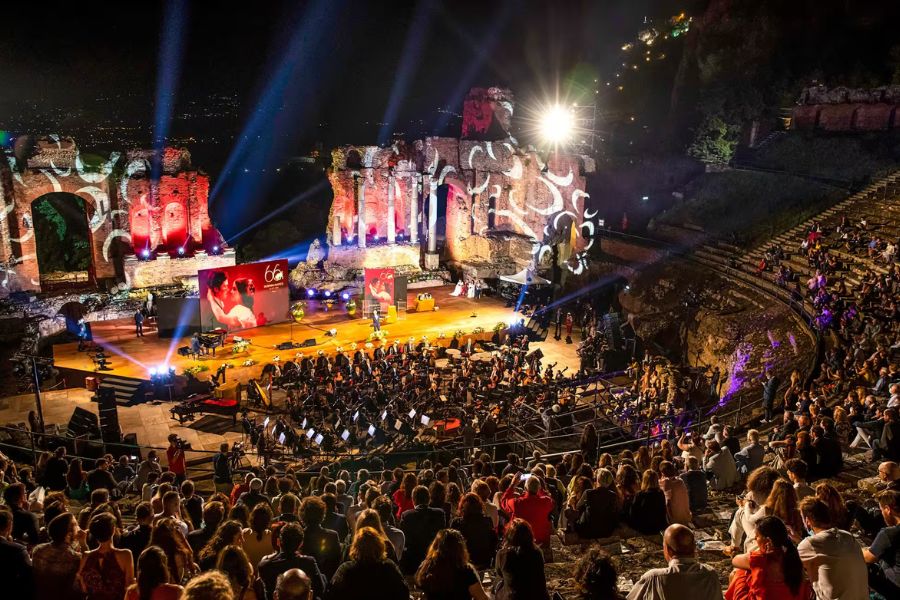
I caught a symphonic concert last summer. As the music soared and the sun dipped behind the Mediterranean, with Etna in the distance, I finally understood why artists dream of performing here.
Unique Acoustics and Stage Design
The theater’s acoustics are honestly incredible. I stood at the center of the stage and spoke in a normal voice, and people at the very top could hear me—no microphones needed. That’s Greek engineering for you.
The semi-circular seating (cavea) gives everyone a great view. The Romans expanded this, adding more decoration and improving the stage.
The original stage building (skene) worked as both a backdrop and a space for actors. Even though it’s partly ruined, you can still see how productions used it. Modern shows blend these ancient elements with temporary staging that doesn’t mess with the original structure.
Capturing the Perfect Mediterranean Backdrop
The Greek Theater in Taormina is a dream for photographers. The ancient stone frames views that mix history, nature, and the Mediterranean’s brilliant blue.
Breathtaking Views of Mount Etna
Mount Etna steals the show in every photo of the theater. On my last trip, I managed to snap the volcano with a light plume of smoke—talk about drama. Etna stands tall in the background, a natural frame that’s wowed visitors since ancient times.
Early morning is the best time I’ve found for photographing Etna. The light paints the slopes gold. If you’re really lucky, you might catch something like what a few visitors saw in July 2024—a show at the theater with Etna erupting behind it.
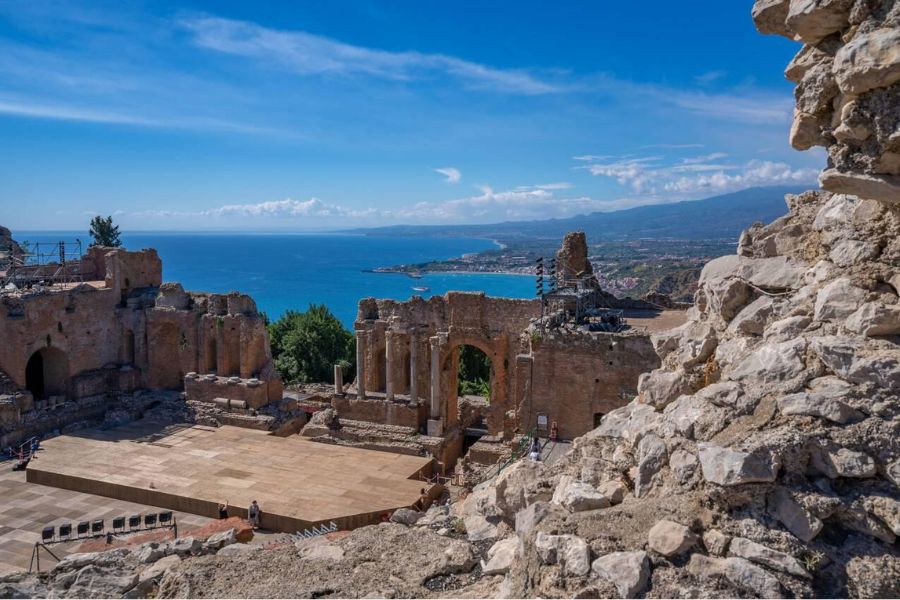
I’d suggest using a wide-angle lens to fit both the ruins and the volcano in your shot. The contrast between old stone and wild landscape gives photos real depth.
Sunset and Panoramic Photography Tips
Sunset transforms the theater into a photographer’s paradise. The golden hour makes the stones glow and the sea below turn a deep blue.
For panoramas:
- Arrive early to grab a spot up high
- Bring a tripod for steady shots
- Use bracketing to manage tricky lighting
- Shoot in RAW for editing flexibility
The theater’s semicircle naturally points your camera toward the sea. I’ve found panoramas work best here, letting you capture both the architecture and the sweeping Mediterranean view.
Finding the Best Angle: Image Orientation and Color Composition
The Greek Theater offers endless options for composition. For vertical shots, I use the ancient columns to frame Mount Etna or the bay.
Color is all about contrast here:
- The warm terracotta of the ruins
- The deep blue Mediterranean
- The green vegetation
- The gray of Mount Etna
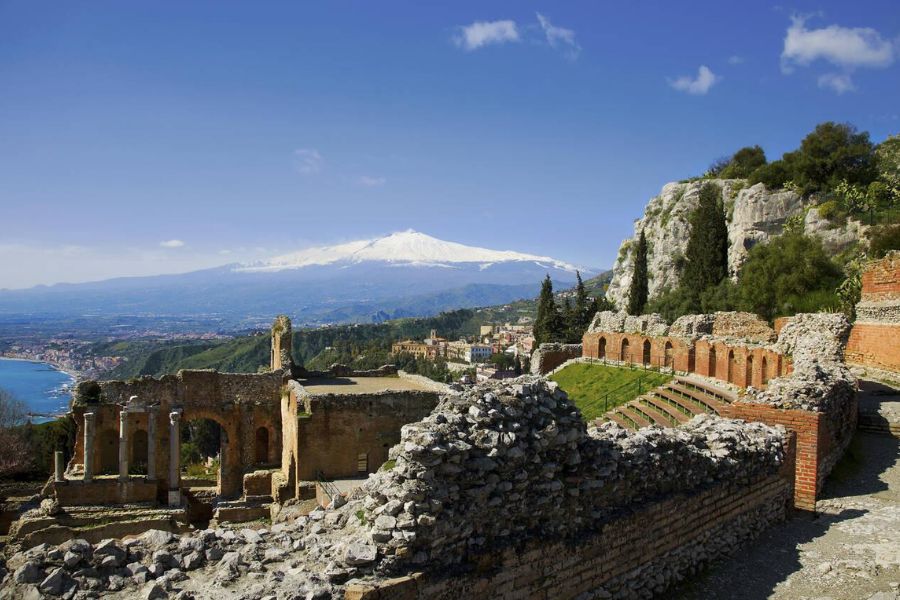
Underexposing just a bit can make those colors pop, especially at midday. I look for patterns in the stone seating to use as leading lines.
Morning light brings out the texture in the stone, while afternoon sun casts dramatic shadows. My best shots have come from moving around and trying new angles, not just sticking to the classic postcard view.
Visual Inspirations From the Greek Theater
The Taormina Greek Theater is an endless source of inspiration for visual creators. Its blend of ancient architecture, Mount Etna, and the Mediterranean makes for unforgettable images.
Stock Photos and Editorial Content
Every time I browse for stock photos of the theater, I’m blown away by the variety. Photographers have captured it at every time of day, showing how light transforms the stone.
Some of my favorite editorial shots are from performances, with the stage glowing under the night sky. These images really show the venue’s ongoing cultural vibe. Aerial shots reveal the perfect semicircle and how the theater sits above the coastline.
The best editorial images often include people for scale, so you can really feel how massive this 3rd-century BC structure is.
Royalty-Free Images, Illustrations, and Vectors
For creative projects, you’ll find loads of royalty-free images of the theater. These work great in blogs, marketing, or educational content about ancient Greek architecture.
Detailed illustrations show off the theater’s features:
- The cavea (seating)
- The orchestra (performance space)
- The scena (stage building)
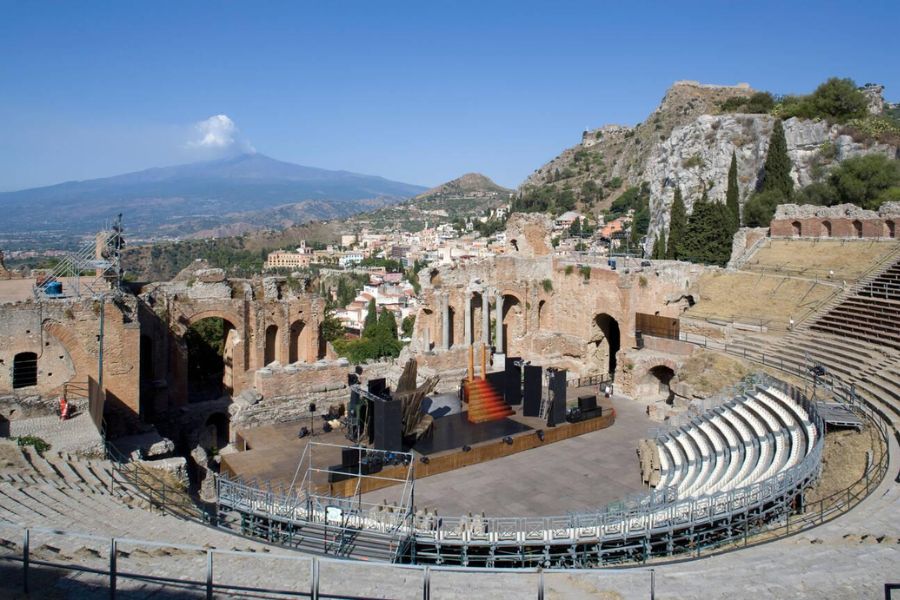
Vector artists have made stylized versions that highlight the theater’s signature look. I’ve come across beautiful line drawings that strip the architecture down to its essentials—perfect for graphic design.
Watercolor illustrations capture the warm limestone against Sicily’s blue skies in a way photos sometimes can’t.
Videos and AI Generated Content
Walking tour videos are popular, letting you “climb” the ancient steps from your couch. Time-lapses show the light shifting over the ruins, spotlighting different features as the day goes on.
AI-generated content is opening up new ways to experience the theater:
- Reconstructions of how it looked in ancient times
- Virtual reality that lets you “attend” a show
- Artistic renderings that mix history with imagination
I’ve noticed AI tools can now create visualizations of ancient performances, with Mount Etna looming behind as Greek actors bring classic tragedies to life.
Practical Visitor Insights
If you’re planning a visit to Taormina’s Greek Theater, a few tips can make your experience way better. Timing, tickets, and a couple local tricks can turn a quick sightseeing stop into a real Mediterranean memory.
Navigating Safe Search Filters for Online Content
Searching for info about the theater online? I’ve noticed some image searches for “Taormina performances” can trigger safe search filters because of ancient statues or performance art.
To get the best info, tweak your search settings or stick to travel sites. The official Taormina tourism site offers family-friendly content about upcoming events and history.

Sites like TravelTaormina.com and museum pages give detailed info without filter hassles. If you’re researching with kids, these are your safest bet.
Tips for the Ultimate Taormina Experience
Go early (8-10am) or late afternoon (4-6pm) to dodge crowds and the blazing Sicilian sun. The theater faces east, so sunrise visits are magical—light pouring over the ancient stone.
In summer, bring:
- A refillable water bottle (there are fountains near the entrance)
- Sun protection (hat, sunscreen)
- Comfortable shoes (the ground is uneven)
Plan for 1-2 hours to really explore. The upper seats have the best views of the stage and Mount Etna.
You can take photos, but you’ll need special permission for tripods. The top center seating is the sweet spot for snapping both the stage and the sea.
Booking and Flash 30% Savings
Tickets run about €10-15 for adults. Students, seniors, and kids usually get a discount.
From October to March, I can usually just grab a ticket at the entrance. But if you’re visiting in summer, you’ll want to book ahead—trust me, the lines get wild.
The theater’s official website sometimes pops up with “Flash30%” deals, especially in April, May, September, or October. If you book at least two weeks early, you can snag a nice 30% off. It’s worth checking for these promos.
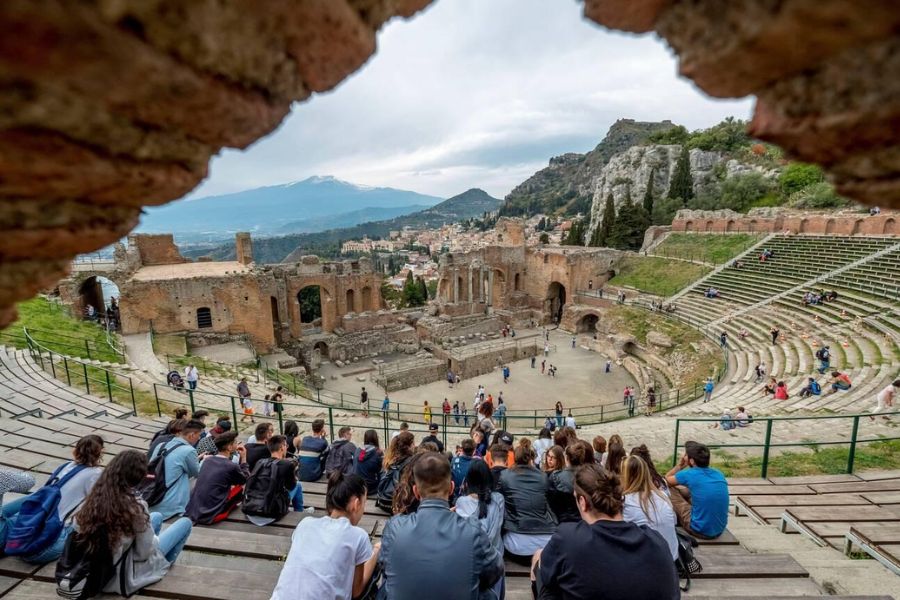
You’ve got a few ways to book:
- Online, straight from the Taormina archaeological park’s website
- Through your hotel (they sometimes toss in a small discount)
- Or with guided tour packages that handle transportation too
If you’re hoping to catch an evening show during the summer festivals, you’ll need to book months ahead. It might sound like a hassle, but honestly, seeing a performance in that ancient theater? Totally unforgettable.

